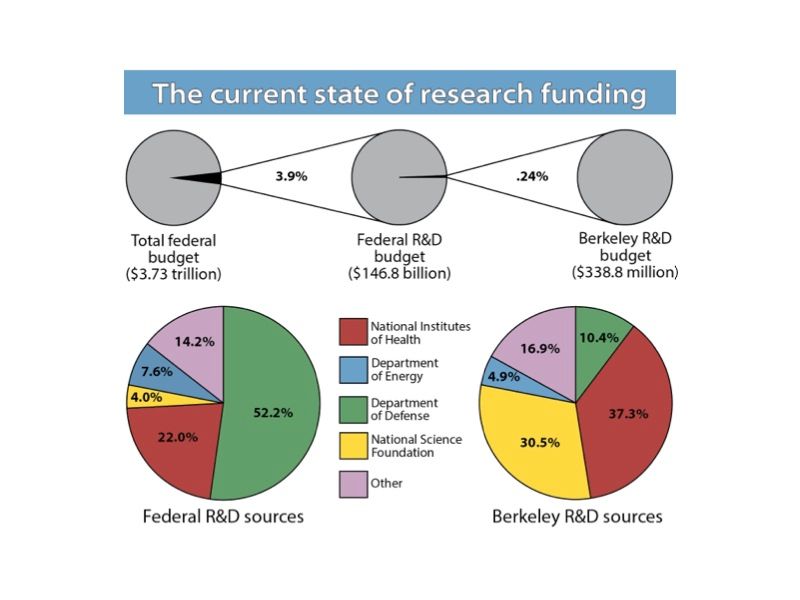
The boom in federal research and development funding in the late 2000s came to a screeching halt after the recession, plummeting to a 30-year low of just 0.74% of the $16.8 trillion US gross domestic product. Research agencies are still staggering from 2013 sequester cuts, which totaled $12.5 billion (8.8%). Although Congress seems poised to increase overall funding levels for scientific research in 2015, uncertainty remains. With many of UC Berkeley’s primary sources for research money hanging in the balance, how can researchers navigate the volatile and chaotic reality of big funding?
One emerging success story is the BRAIN (Brain Research through Advancing Innovative Neurotechnologies) Initiative. In less than three years this multiagency program experienced an astonishingly fast turnaround from a seed of an idea among researchers to guaranteed, presidentially mandated funding through the National Science Foundation (NSF), the National Institutes of Health (NIH), and the Defense Advanced Research Projects Agency. Beginning with the provocative idea to record data simultaneously from every neuron in the brain, the initiative quickly garnered support from the wider scientific community, forming a quorum of over 100 researchers—including 42 from UC Berkeley alone. Then, focus turned to Washington.
The quorum found a staunch White House ally in Tom Kalil, deputy director of technology and innovation. “He pushed to make it bigger, saying ‘I can sell it to the president as a grand challenge initiative’… which he did,” said quorum member John Ngai, UC Berkeley professor of molecular and cellular biology and neuroscience. Their efforts culminated with an invitation to the White House in April 2013, where President Obama announced his support for BRAIN, an experience that left those in attendance “giddy.” Further political advocacy work led to the promised funding actually materializing in the 2014 NIH budget. Ngai is still amazed by their success, saying, “this is a political game. Just for the President to get through $100 million in the 2014 budget was huge.” In a world where “flat is the new up” is the current motto for budget success, this result is especially significant.
However, $100 million, less than two percent of existing NIH spending on neuroscience, is only a start. According to Ngai, “some people look at the BRAIN Initiative as a funding opportunity, and I think that’s a mistake. To me, it’s a huge opportunity to do something really transformative. You need money to do this, but you need to think about what transformation you want before you think about the money. If you think about it the other way around, you’re just going to get yourself through the next funding period.” In fact, BRAIN researchers are already moving forward with plans for the next decade, and have requested a 300-500% yearly increase in funding from the NIH, totaling $4.5 billion over ten years. This ambitious request still requires approval from Congress for additional funding–without this, the NIH might need to divert funding from other neuroscience initiatives to reach the requested levels.
Unpredictability in funding for scientific research is unlikely to disappear in the near future. Science philanthropy organizations can act as both policy advocates and additional sources of research dollars, but passionate game-changing efforts by researchers themselves may be the best way to secure the future. At the interface of technology and science, the BRAIN Initiative’s success demonstrates a powerful form of advocacy: a quorum of top-notch, multidisciplinary researchers that band together under the umbrella of a “grand challenge” idea.
Field-wide scientific consensus convinces Washington leaders and the President that large-scale research endeavors are worth their support. UC Berkeley is now reaping the benefits of this effort: $7.2 million in BRAIN grants to UC Berkeley researchers, Ngai among them, were announced at the end of September. Vice Chancellor for Research Graham Fleming expresses optimism about UC Berkeley’s position in the future of scientific research: “When the horrible budget cuts happened in 2009, we were faced with a decision: were we going to circle the wagons and protect what we have, or are we going to do new things? We have to take risks and keep doing new things…and I think that it’s paying off.”
This article is part of the Fall 2014 issue.



